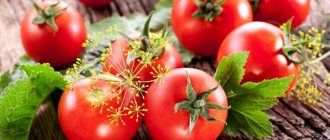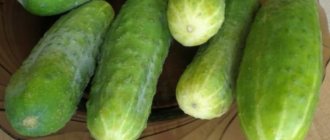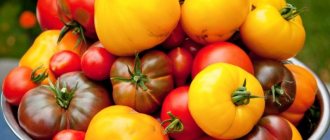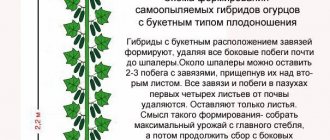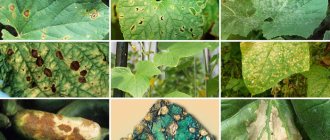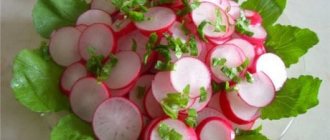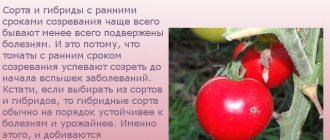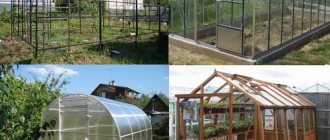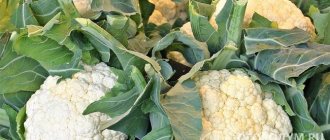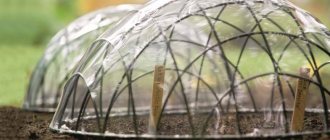- The best varieties of cucumbers for the greenhouse
- Bunch varieties of cucumbers for the greenhouse
- Self-pollinating varieties of cucumbers for greenhouses
- Cucumber varieties for polycarbonate greenhouses
- Yield varieties of cucumbers for greenhouses
- Early cucumber varieties for greenhouses
- Dutch varieties of cucumbers for greenhouses
- Cucumber varieties for winter greenhouses
- Resistant varieties of cucumbers for greenhouses
It would seem that growing cucumbers in a greenhouse would not be difficult even for a novice amateur. However, unlike cucumber varieties for open ground, in order to get a guaranteed harvest, you need to wisely select varieties specifically designed for cultivation in closed ground. Parthenocarpic and self-pollinating varieties that do not require pollinators make it possible to grow cucumbers in protected ground under any weather conditions. A special approach is needed when choosing varieties for polycarbonate and heated winter greenhouses.
Most modern varieties and hybrids of cucumbers have excellent taste, decent yield, and complex resistance to viral and fungal infections. For lovers of experiments and exotics, there is always a chance to try Dutch new products and proven varieties.
The best varieties of cucumbers for the greenhouse
Earning the title of best variety is not easy, because every gardener has his own favorites. First of all, the best variety never fails, has excellent fruit flavor and is the least hassle to care for.
Based on some reviews and personal experience, we can recommend the best varieties of cucumbers for greenhouses, such as
- Hercules (2002),
- Emelya (2002),
- Dynamite (2002),
- Athlete (2002).
- Real Colonel F1
Athlete
The first cucumbers ripen in less than 2 months and are good fresh and in salads. Pollinators are needed for good fruit set.
- An indeterminate plant with a mixed type of flowering, the bush grows actively.
- Zelentsy are large, cylindrical in shape, up to 20 cm long and up to 4.5 cm in diameter. The taste is rated excellent.
- The color is dark green with smeared stripes.
- The yield is impressive - up to 27.2 kg per 1 m².
The hybrid has a significant fruit weight - up to 180 g on nutritious soil. Not afraid of powdery mildew.
| Important To increase soil fertility on the site and grow organic food, biological products, for example, Ekomik Urozhainy, will help. Living microorganisms of the biological product contribute to the active decomposition of soil organic matter, the accumulation of nutrients and mobile forms of macro- and microelements. Plants are supplied with the necessary nutrients. The structure of soil biota is improved and accumulated phytopathogens are suppressed. The level of plant disease is reduced, growth and development are stimulated. The biological product starts the process of soil self-cleaning from residual pesticides. |
Photo: Biological product EKOMIK UROZHAYNIY for growing healthy and environmentally friendly products
Real Colonel F1 |
Popular parthenocarpic hybrid True Colonel F1 for spring greenhouses, tunnels, open ground. One of the most famous cucumbers of domestic selection.
Early ripening, female type of flowering, stands out for its friendly yield, simultaneous filling of a large number of fruits on the plant, and high yield of standard products.
- Branching is average or below average.
- The greens are beautifully bright green in color, lumpy, white-thorned, 12-15 cm long.
- The tubercles are large, the frequency of tubercles is average.
- The taste and pickling qualities deserve the highest praise.
- The purpose of the fruit is universal.
Resistant to olive spot, common cucumber mosaic virus, tolerant to powdery mildew, root rot.
Order seeds here
Review of the variety Real Colonel
This is a typical parthenocarpic, so you can forget about additional pollination. The plant is characterized by indeterminateness and medium branching. The flowers are mostly female, green flowers have a spindle shape and a short neck, they are slightly ribbed, green with moderately long stripes. The tubercles on the fruits are medium in size, sparse with white pubescence.
- The Real Colonel's greens usually weigh about 120 g, with a yield of about 13.5 kg per 1 m².
- Already 41 days after germination, you can get the first fruits.
- The length of the greens sometimes reaches 15 cm, the diameter often exceeds 4.5 cm.
The taste of both fresh and canned fruits is equally ideal.
Photo: productive parthenocarpic hybrid for a greenhouse Real Colonel F1
Hercules
Salad, bee-pollinated hybrid. After just 60 days you can get the first fruit harvest. It also has a significant fruit weight - from 150 to 170 g.
- The bush is indeterminate, grows and branches actively.
- Zelentsy have an interesting spindle-shaped shape, reach a length of 16-17 cm and a diameter of 4.0-4.5 cm. The taste is good.
- They are painted dark green with light stripes on the sides. Not very long and sparse tubercles with white pubescence are noticeable on the surface.
- Productivity is high - up to 28.8 kg per 1 m².
Not affected by viral and fungal infections (cucumber mosaic virus, olive spot virus, root rot).
The variety is also of the bunch type and is recommended for growing in heated greenhouses in the winter and spring.
Emelya
Parthenocarpic hybrid for salad purposes with excellent taste. The first harvests are produced quite early, on average 41 days after emergence.
- Zelentsy grow 120-150 g, up to 15 cm long and up to 4.5 cm in diameter.
- The bush is indeterminate, actively growing, usually with a predominance of female flowers.
- Zelenets has a bizarre spindle-shaped shape with short and light stripes.
- The yield is decent - up to 16 kg per 1 m².
Also perfect for growing in a polycarbonate greenhouse. The ovaries are formed of a bunch type. Resists many diseases.
Tips and recommendations for choosing for different regions of the country
Protected soil conditions, especially when covered with high-quality polycarbonate, partially smooth out climatic differences between regions. Many greenhouse cucumber hybrids have a certain versatility and successfully bear fruit in all regions.
But there are still some peculiarities in some important aspects:
- length of daylight hours;
- the ratio of cloudy and sunny weather;
- season length;
- temperature contrasts.
Modern breeders take into account the needs of different territories and create cucumber hybrids with “telling” names. Amateur vegetable growers can easily navigate them and choose zoned varieties for their region.
For the Moscow region
Greenhouse cucumber hybrids for Moscow and surrounding areas are offered by the breeding department. It continues the best traditions of the Soviet Timiryazev Academy. Well-known geographical concepts are reflected in the names of popular parthenocarpic hybrids of cucumbers: Podmoskovnye Vechery F1, Chistye Prudy F1, Maryina Roshcha F1. They are successfully cultivated by vegetable growers in the Middle Zone.
For the Urals
The Ural region is famous for temperature contrasts and weather disasters. But gardeners know how to get decent yields of greenhouse cucumbers. Those of them who choose self-pollinating hybrids with a “Ural character” will not be mistaken: Ural Gherkin F1, Ural Express F1, Ural Malachite F1, Taganay F1.
For Siberia
The sharply continental Siberian climate, with its deceptive warmth and short summers, dictates its own laws even for polycarbonate greenhouses. In the genetics of hybrid cucumbers for Siberia, breeders include maximum resistance to the vagaries of bad weather. They are easy to find by the names of the varieties: Siberian Express F1, Siberian Garland F1, Siberian Skorokhod F1, Siberian Large F1.
Previous
CucumbersHow to treat root rot in cucumbers
Next
CucumbersDescription, characteristics, cultivation and reviews of cucumber variety Marinda F1
Bunch varieties of cucumbers for the greenhouse
Varieties and hybrids of bunch-type cucumbers allow you to harvest decent harvests even in limited areas. In addition, bunch varieties are a godsend for summer residents who cannot visit their plots every day.
Among the bunched cucumbers recommended for growing in greenhouses, we can recommend the following varieties:
- Acorn (2008),
- Ajax (2000),
- King of the Garden (2010) and Gavroche (2010),
- bee-pollinated hybrid Hercules ,
- parthenocarpic Emelya,
- super bunched cucumbers from Manul
Acorn
A typical bunch variety of mid-early ripening, suitable for salad, canning and pickling at the same time. The type of plant is indeterminate, it is medium-sized, weakly weaving, the flowers on it are mostly female, there are up to 12 ovaries in the nodes! Zelentsy are short, spindle-shaped and green in color with stripes. The surface of the variety is tuberculate, the pubescence is whitish and of medium density. The weight of greens on good soil reaches 111 g, with good taste and a yield of 9 kg per 1 m². The variety is also resistant to cladosporiosis.
King of the bed
Bunch variety, number of ovaries in a bunch is about 6 pieces. This is an early ripening hybrid that has a parthenocarpic type of pollination and is used for salad and canning purposes. The plant is indeterminate, weak-growing, weakly branched, and contains predominantly only female flowers. The greens of the variety are quite short, cylindrical in shape and dark green in color with stripes. There is slight spotting along the stripes, large tuberculation and sparse white pubescence. The maximum weight of greens reaches 125 g on good soil, with excellent taste and a yield of just over 11 kg per 1 m². The good thing about this variety is that it is resistant to cladosporiosis, as well as various root rots.
Gavroche
There are no more than 5 fruits in a bunch. This is a typical parthenocarpic, intended both for use in salads and for canning. The first fruits can be obtained 42 days after full germination. The plant branches quite actively, bears almost all female flowers and forms short green flowers, with slight ribbing, cylindrical shape and green color with short stripes. The tubercles are small, the pubescence is snow-white, of medium density. The weight of the fruit on good soil can reach 85 g. The taste of the fruit is excellent, and the yield per 1 m² sometimes reaches 11.4 kg. The variety is resistant to cladosporiosis.
Self-pollinating varieties of cucumbers for greenhouses
Self-pollinating and parthenocarpic varieties and hybrids are perfect for growing in greenhouses when there is no hope for weather, and the arrival of pollinating bees is in question. Parthenocarpic varieties even form ovaries without any pollination, therefore they are recommended by the state register for indoor soil.
Among parthenocarpic and self-pollinating cucumbers for greenhouse conditions, we can recommend varieties
- Amazon (2002),
- Anyuta (2002),
- White angel (2002),
- cornflower (2002),
- Emelya.
Amazon
Parthenocarpic hybrid for salad purposes. Cucumbers are green, smooth, even, with slight white pubescence. The taste is good.
- It begins bearing fruit on days 72-74 after full germination. The bush is indeterminate, vigorous, with a female type of flowering.
- Zelentsy are cylindrical in shape, quite large: about 30 cm in length, up to 4.5 cm in diameter, weighing more than 300 g.
- The yield per 1 m² reaches 22.5 kg.
- Not susceptible to olive spot and ascochyta blight.
Also suitable for growing in heated greenhouses in winter and spring.
Anyuta
Problem-free parthenocarpic hybrid. Good in salads, long-lasting fruiting. Indeterminate plant, actively growing bush, predominantly female type. The greens are short-fruited, tuberculate, spindle-shaped, dark green in color and have snow-white pubescence.
- The first fruits are produced already on the 38th day from full germination.
- The maximum weight of greens is about 120 g, with a length of 12 cm and a diameter of about 3.7 cm.
- The taste is good, and the yield can reach 17 kg per 1 m².
Resistant to many diseases, not afraid of downy mildew.
White angel
Hybrid of parthenocarpic type. Good in salads and for canning. Starting from 44 days after full germination, it is ready to bear fruit. Indeterminate plant, actively growing bush, with a mixed type of flowering. Zelentsy are cylindrical in shape, they are white with medium-sized tubercles and white pubescence.
- The maximum weight of greens is about 90 g, its length reaches 11 cm, and its diameter is slightly more than 3.6 cm.
- The taste of both fresh and canned fruits is excellent.
- Productivity reaches 16 kg per 1 m².
It is valued for its decent yield, short fruiting, tuberous greens and high taste.
General's F1
The early ripening superbunch hybrid General F1 is not afraid of cold, shade and disease. Zelentsy grow evenly, up to 12 cm in length. They have a pleasant taste and crunch. You can harvest up to 400 greens from one plant per season. The type of branching in cucumbers is self-regulating, so if you come to the dacha only on weekends, you don’t have to worry that the greenhouse will turn into a cucumber jungle. It will also take less time to pinch out the side shoots. Another plus of the General F1 is that fruiting lasts until late autumn!
Cucumber varieties for polycarbonate greenhouses
Polycarbonate greenhouses are often hotter than film and glass greenhouses. Therefore, varieties and hybrids suitable for growing in polycarbonate greenhouses should easily tolerate elevated temperatures and overheating.
Among these varieties we can recommend:
- Murashka (2003),
- Emelya (2002),
- Sarovsky (2007),
- A real colonel (2004).
Murashka
Parthenocarpic hybrid for universal use. The bush is vigorous, of unlimited growth type. Zelentsy are cylindrical in shape, dark green in color with medium tubercles and black pubescence.
- After full germination, cucumbers appear on the 45th day.
- The cucumbers taste excellent, weighing approx. 100 g, up to 13 cm long, 3.5-4.0 cm in diameter.
- The yield reaches 12 kg per 1 m².
The variety is valued for its early ripeness, decent yield, short fruiting, and tuberous greens.
Photo: parthenocarpic cucumber hybrid for the Murashka F1 greenhouse
Sarovsky
The plant is indeterminate, it is vigorous and grows in one stem. The greenery itself is quite short, its shape is cylindrical, and the color is dark green. If you look at the surface, you can see large tubercles and whitish pubescence, the density is average.
- Early ripening hybrid, typical parthenocarpic, salad type, canning purpose.
- It weighs 110 g, but its yield per 1 m² is more than respectable - up to 15.5 kg.
- The taste is good, the advantage is the uniform formation of the harvest.
Murashka F1
A universal and high-yielding hybrid with many advantages. Murashka F1 is early ripening, does not require pollination by insects and is resistant to powdery mildew and cladosporiosis. Rarely forms barren flowers. From one plant in a greenhouse you can harvest up to 12 kg of greens. The fruits do not overgrow on the bush, do not taste bitter and are distinguished by juicy pulp and a pleasant crunch. The seeds are small and soft, the skin is thin. Cucumbers are suitable for salads and homemade preparations. The peculiarity of Murashka F1 cucumbers is their long fruiting period: the harvest can be harvested almost until the end of September.
Yield varieties of cucumbers for greenhouses
Among the fruitful ones, we can distinguish large-fruited hybrids, which produce up to 28 kg per 1 m² with a green foliage length of approx. 30 cm and weighing 300 g. These include Athlete, Hercules, Amazon. There are also varieties with smaller fruits, which will yield 12-13 kg of yield with a cucumber weight of 100 g.
Among these we can recommend varieties:
- Cartoon (2010),
- Matrix (2009),
- Bobrik (2006),
- Quadrille (2006),
- Dutch hybrid Gunnar .
Quadrille
The weight of greens usually exceeds 100 g, and the yield is always higher than 11 kg per 1 m². In addition, this is a typical parthenocarpic, used for salads and canning. Already on the 39th day it can bear the first fruits.
- It is distinguished by its indeterminate nature, branches to an average degree with a predominance of the female type of flowering.
- The greens are quite short, which is excellent for pickling; they have a cylindrical shape and a green color with barely blurred stripes.
- Noticeable tuberculation, white and rather dense pubescence.
- The taste is excellent and, among other things, the variety is resistant to cladosporiosis.
Quadrille can also be recommended as an early ripening, parthenocarpic variety.
Matrix
The Matrix variety has slightly larger greens (up to 110 g) and a higher yield - more than 12 kg per 1 m². This is a typical parthenocarpic for salad purposes. Already on the 41st day it produces the first fruits.
- Branches weakly, the female type of flowering predominates.
- The greens themselves are short, with rather large tubercles, white pubescence, and medium in density.
- The taste is simply wonderful.
- The variety is resistant to fusarium.
Cartoon
The greens ripen more than 140 g, and the yield reaches 13 kg per 1 m². This is a parthenocarpic that does not require pollination, is used in salads and canned. On the 39th day it bears its first fruits.
- The plant itself branches weakly and produces predominantly female flowers.
- Zelentsy are medium in size, cylindrical in shape and dark green in color with short stripes.
- Small tubercles and white pubescence, very dense, are noticeable.
- The taste of greens is simply excellent.
- The variety is resistant to cladosporiosis.
Dynamite F1
The universal early maturing hybrid Dynamite F1 is quite unpretentious. He is not afraid of drought and heat. The bush also does not need pollination. But he will be glad if you provide him with enough space to grow and bear fruit. It is resistant to common diseases. Zelentsy grow small - up to 14 cm long and weighing up to 120 g. Approximately 6-7 kg of cucumbers are harvested from 1 square meter of plantings, under favorable conditions - up to 15 kg. The fruits are well transported. Most often used for salads.
Early cucumber varieties for greenhouses
It is convenient to grow early-ripening varieties of cucumbers in greenhouses and get the first harvest at the beginning of summer. The earliest varieties of cucumbers include those cultivars that ripen in less than 40 days from the moment of full germination.
Among the early ripening cucumbers intended for growing in a greenhouse, we can recommend:
- Amur (2000),
- Anyuta,
- Quadrille (2006),
- Caricature (fruits for 37-39 days);
- Pace (2006),
- A real colonel,
- Courage (2002),
- Matrix (begin to bear fruit on days 41-43)
Amur
You can taste the first greens of the variety 37-39 days after emergence. This is a typical parthenocarpic, its purpose is mainly salad.
- This plant itself is indeterminate, actively growing, weakly climbing.
- The flowering type is mainly female.
- The green grass has a spindle-shaped shape, rather short (13-14 cm), small tubercles, a short neck, green color with small stripes, whitish pubescence.
- The maximum weight of greens on good soil reaches 112-115 g, the taste is excellent, and the yield often exceeds 14 kg per 1 m².
One of the advantages is resistance to the cucumber mosaic virus.
Courage
A reliable variety, it gives the first harvest after 41 days from germination. There is no need to worry about pollination since it is a parthenocarpic, both for salad and canning purposes.
- The growth type is indeterminate, the bush grows actively, although the branching is average in strength and the foliage is weak.
- There are significantly more female flowers on the plant. The shape of the greens is cylindrical, the color is green, and smeared stripes are visible on the surface, reaching a third of its length.
- The ribs are very weak, as are the tubercles, but the latter are located quite often, as is the whitish pubescence.
- Greenery on good soil can reach 100-120g, a length of 15 cm and a diameter of almost 4.6 cm.
- Productivity reaches a record level of 18 kg per 1 m².
The taste is simply wonderful both fresh and canned cucumbers. ______________________________________________
Read more about the variety in the article Cucumbers Courage: description, characteristics, reviews
conclusions
It’s not enough to simply choose the appropriate variety of cucumbers (the name of the new productive variety) for the greenhouse. It is necessary to select the highest quality seeds from the numerous quantities offered by various manufacturers of planting material, and manage not to run into a fake. You should not purchase seeds from unknown manufacturers or suspiciously packaged ones. There is no need to save on planting material: high-quality seeds produced by well-known brands, as a rule, are not cheap. It is better to overpay and buy reliable material from which a rich harvest will grow, than to purchase a dubious cheap fake produced in some basement.
Also read about bush plants for open ground and greenhouses.
Dutch varieties of cucumbers for greenhouses
Those who like to experiment in their own dacha can try Dutch exotica. The recommended varieties are included in the state register and are suitable for growing in greenhouses under Russian conditions. Among the Dutch representatives, the following varieties can be distinguished: Angelina (2008), Gunnar (2014), Hector (2002) and Betina .
Angelina
Early maturing Dutch hybrid. A typical parthenocarpic for salad purposes. The plant belongs to the indeterminate type, it is of average growth vigor, with a predominantly female flowering type. Zelentsy are quite short, their shape is cylindrical, the surface is tuberculate, and the pubescence is whitish and very sparse. The cucumbers grow quite small - from 60 to 60 g. The taste is excellent. The variety is not affected by cladosporiosis.
Gunnar
Mid-season in terms of ripening, both for salad and canning purposes. It is a parthenocarpic that does not require pollination, of an indeterminate type with predominantly female flowers on the plant. The greenery itself is short, has a spindle shape and large tubercles on the surface; in nutritious soil and with sufficient moisture it reaches 118 g. The variety is rated the highest in taste. Productivity per 1 m² is 20.9 kilograms. In addition, this variety is resistant to cladosporiosis.
Hector
It is distinguished by early ripeness, belongs to the salad type, but is also often used in the canning industry. This is a determinate plant, having the form of a large bush, although quite compact with a predominance of female flowers on it. Zelentsy have a cylindrical shape, green color, rare but rather large tubercles and whitish pubescence. Greenery on good and nutritious soil often exceeds 100 g, its length is about 13 cm, and its diameter is just over 3.4 cm. The taste is simply excellent. Productivity is low - only 4 kg per 1 m². The good thing about this variety is that it is completely resistant to cucumber olive spot, cucumber mosaic virus, and powdery mildew.
Features of cucumbers suitable for growing in greenhouse conditions
In protected ground, many varieties of cucumbers, suitable for growing both in open and indoor ground, often show higher yields. This is due to the fact that in greenhouses this delicate, heat-loving crop is protected from unfavorable weather conditions or temperature fluctuations, and from unexpected cold snaps.
Nowadays polycarbonate greenhouses are very popular - they are easy to install on the site and these structures are quite reliable. Growing cucumbers in a polycarbonate greenhouse will allow you to get a good harvest
with a relative minimum of labor costs for the manufacture of a glass greenhouse. From a financial point of view, this is also more profitable.
When choosing varieties and hydrides of seed material of this vegetable plant, you need to clearly know what requirements are imposed on plants:
- the harvested crop will be used for conservation or food;
- at what time of year will cucumbers be grown indoors;
- size of ripe fruits.
You also need to pay attention to how specific varieties or hybrids are pollinated:
- insects;
- are self-pollinating;
- parthenocarpic (not requiring pollination).
When growing varieties that required pollination by bees, it was necessary to attract these flying insects into greenhouses or place hives in them. Sometimes it is not possible to attract bees, in which case you have to pollinate the female flowers manually, but this procedure will have to be repeated regularly in order to get a good harvest as a result.
When growing self-pollinating and parthenocarpic cucumbers, summer residents do not have such problems. But these types of cucumbers are unlikely to be able to collect seed material for further planting, so seeds have to be purchased annually. But, as a rule, with the right choice of variety, the high yield of such hybrids always pays off with a large margin.
The main positive qualities of cucumbers grown in greenhouses should be:
- self-pollinating;
- high resistance to diseases;
- shade tolerance.
Cucumber varieties for winter greenhouses
For winter heated greenhouses, varieties are suitable that easily tolerate artificial sources of light and heat and grow with a lack of sunlight. Among these varieties are: Amur (2000), Baloven (2004), Ginga (2002), hybrids Hercules and Amazon .
Minion
A variety for salad and canning purposes, it produces its first fruits after 45-46 days, and is distinguished by its indeterminate nature, vigorous growth and abundant foliage formation. It branches weakly, and the plant produces mostly female flowers. Zelentsy have an oval shape and a short neck, they are green, with medium ribbing and tubercles of both medium density and medium size and interesting black pubescence. On good soil, the weight of greens can exceed 82 g, the length is just over 10 cm, and the diameter is 3.2 cm. The taste of greens is ideal, and from 1 m² you can collect more than 14 kg of fruit.
Resistant varieties of cucumbers for greenhouses
Most modern varieties and hybrids are characterized by complex resistance to viral and fungal diseases of cucumber. Among the most resistant varieties we can recommend: Pasadena (1998), Natalie (1998), Masha (2000) and Octopus (1998).
Pasadena
The variety is resistant to cladosporiosis, powdery mildew, and is not afraid of the cucumber simple mosaic virus. Medium-early ripening variety, typical parthenocarpic, for salad and canning purposes. The bush, depending on the type of soil, can be either low-growing or vigorous, with a female type of flowering. The greens are tuberculate, with whitish pubescence, cylindrical in shape, green and dark green in color. The length of the greens is small, there is spotting and ribbing, the tuberculation is medium, and there is no bitterness at all. On good soil, greens can reach 93 g and have a very good taste.
Natalie
Resistant to olive spot, bacteriosis, brown leaf spot, successfully resists ascochyta blight, powdery mildew, downy mildew (peronospora) and even root rot. This is a salad variety, but it can also be used for canning. The first fruits can be obtained on the 46th day from emergence. The plant type is indeterminate; it is long-climbing with an abundance of leaf blades. The type of flowering is predominantly female. The length of the greens is usually about 12 cm, it has an oval-cylindrical shape. The color of the fruit is green, there are barely visible, smeared stripes. On good soil, greens reach a weight of 135 g, have a good taste, completely devoid of bitterness, and a yield of more than 10 kg per 1 m².
Masha
Resistant to olive blotch, cucumber mosaic virus and powdery mildew. It is characterized by early ripening, has the property of parthenocarpy, as well as salad and canning purposes. The plant is of average growth, rather of a determinant type. Zelentsy are usually cylindrical in shape, have large tubercles on their surface but are medium in density. The color of greens is dark green, there are stripes, but they are very light, with white pubescence and a complete absence of bitterness. Zelentsy reaches a length of 9.2 cm, the diameter barely exceeds 3.6 cm. The taste is excellent in both fresh and canned fruits, and the yield reaches 11 kg per 1 m².
Emelya F1
The early-ripening, productive hybrid Emelya F1 does not require pollination. Designed for greenhouses, but can also bear fruit on the balcony. Zelentsy ripen in about 40 days and are distinguished by thin, delicate skin and large tubercles. Their taste is especially surprising - sweet, juicy, without bitterness. Even overgrown fruits do not lose these qualities. Fruit length – 13-15 cm, weight – 120-150 g.
Emelya F1 is universal, good for salads and a variety of seams. Resistant to many diseases, but can sometimes suffer from downy mildew and root rot. Adapts well to low temperatures and will withstand moderate lack of light. Requires shaping and gartering, because the lashes sometimes reach a length of 2.5 m or more.
